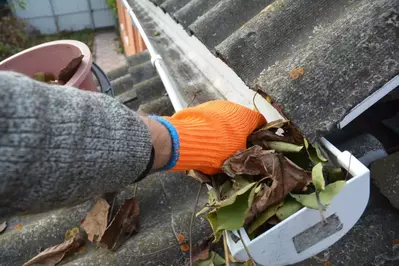The lively greens of summer give way to vibrant shades of reds, yellows, and oranges in the fall. In North Carolina, this season brings new responsibilities. An often overlooked yet critical task for homeowners is preparing gutters for falling leaves and debris. Proactive gutter maintenance before the fall season can save you unnecessary stress and costly repairs. Keep reading to learn more about how to prepare your North Carolina gutters for fall.
Why Do I Need to Prepare My North Carolina Gutters for Fall?

North Carolina experiences a distinct fall season with abundant foliage and sometimes heavy rainfall. This combination creates the perfect conditions for clogged gutters. Neglecting your gutter system during this time can lead to a variety of problems, such as:
- Gutter damage: The weight of leaves, debris, and standing water in a clogged gutter can cause it to sag, pull away from your home, crack, or detach completely, requiring repairs or replacement.
- Water damage: Gutters are designed to channel water away from your home. When gutters overflow, the water pours directly onto the foundation, potentially leading to cracks, basement, flooding, and structural damage over time.
- Landscape erosion: Overflowing water from your gutters can erode soil and damage plants, wreaking havoc on the landscaping around your home.
- Rotting fascia: A clog can cause water to seep behind the gutters, saturating the fascia boards and soffits. This moisture can lead to wood rot and comprise the integrity of your roof.
- Pest infestations: Clogged gutters create damp, stagnant environments that are ideal breeding grounds for mosquitoes and can attract other pests like insects and rodents.
Steps to Prepare Your North Carolina Gutters for Fall
Taking the time to prepare your North Carolina gutters for fall is a worthwhile investment in the health and longevity of your home. Some of the essential steps include:
1. Prioritize Safety

Before you start preparing your North Carolina gutters for fall, make sure you prioritize safety. Use a sturdy ladder on level ground, and have someone with you to spot you. Wear work gloves to protect your hands from sharp objects and potential contaminants. If you don’t have the proper gutter cleaning tools or you’re uncomfortable with heights, you can hire professional gutter cleaning services.
2. Clear Out Debris
Manually remove all leaves, twigs, pine needles, and other debris from your gutters. You can use a small trowel, a gutter scoop, or your glove-covered hands to scoop out the debris. Debris tends to accumulate most in the corners and downspout openings.
3. Flush with Water
Once the debris is cleared, use a garden hose with a strong nozzle or a pressure washer to flush them out. Start from the highest point and work your way down to dislodge any remaining pieces of debris and dirt, ensuring water flows freely towards the downspouts.
4. Check Downspouts

As you flush your gutters, watch to make sure water is freely flowing out of your downspouts. If the water backs up, this means there is a clog. You may be able to clear minor clogs by tapping on the downspout, inserting a plumber’s snake, or spraying a strong stream of water through it. For stubborn clogs, professional assistance may be necessary.
5. Inspect for Leaks and Damage
Now that your gutters are clean, take the opportunity to inspect them thoroughly. Check for any signs of damage, such as holes, cracks, sagging sections, or loose fasteners. Look for any leaks at the joints or seams. Small cracks may be able to be sealed with gutter sealant, but significant damage will require repairs or replacement.
6. Check Pitch
Gutters should have a slight pitch, or slope, towards the downspouts for proper drainage. If you notice standing water in your gutters after flushing, this could indicate improper pitch or a sag. This can often be corrected by adjusting the hangers or re-securing the gutter.
7. Consider Gutter Guards

To protect your gutters and reduce the need for maintenance, consider installing gutter guards. There are various types available, each with its own advantages. Gutter guards help prevent large debris like fall leaves from entering and clogging your gutters, reducing the frequency of cleaning and maintenance.
8. Trim Overhanging Branches
Are any tree branches directly overhanging your roof and gutters? Trim these branches back to reduce the amount of leaves and debris that can fall into your gutters, lessening your workload during and after the fall season.
9. Continue Regular Maintenance Throughout Fall
Even after a thorough cleaning, the fall season will require more frequent gutter checks. After heavy rain, wind, or leaf falls, it’s a good idea to quickly inspect your gutters to make sure they have not gotten clogged.
North Carolina Gutter Services

If gutter cleaning and maintenance feel overwhelming, we can help! You can trust GutterPro for reliable and efficient gutter services for your North Carolina home. We offer gutter cleaning, gutter repair, gutter installation, and gutter guards to help keep your home safe while also maintaining its curb appeal. Reach out to us today to find out more about how we can help prepare your North Carolina gutters for fall!




![rain-chain-1000x600[1]](/media/68368d5a07f7959e9af4536c/medium.webp)






